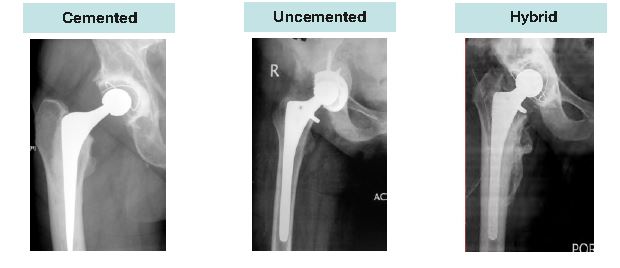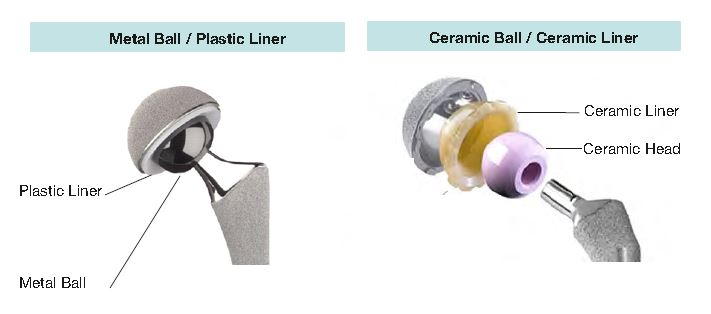Yes, both the hips can be replaced at the same sitting if you are medically fit. It means one time anaesthesia, one time hospital stay, one time surgery and one time pain medication. It will be cost effective as well. Your doctor can advise you if you can undergo replacement of both hip at the same sitting.
Total Hip Replacement
What is the right age for Total Hip Replacement ?
As such age is no bar for this surgery, but preferably should be donein the older age group.
In younger age group, it should only be considered when patient isseverely crippled due to severe rheumatoid arthritis post traumaticarthritis of hip or avascular necrosis (AVN).
What are the benefits of Total Hip Replacement ?
Total hip replacement is the most successful joint replacementoperation. Relief of joint pain is often dramatic. The restorations ofactivities for sedentary adults are complete.
Most of you will regain your activities and will be able to walk wellwithout any limp, and will not require any walking aid. Improvementin stiffness especially in rheumatoid arthritis is significant.
Restoration of limb length of the leg is also an important advantageof this operation.
It must be remembered that artificial hip joint is a good hip thoughnot a normal hip. While swimming and brisk walking is consideredsafe, heavy labour jobs or repeated heavy impact should beavoided.
However after surface hip replacement most of the patients can domoderate impact activities such as golf and tennis in addition tositting on floor.
Are you a candidate for total Hip Replacement ?
Total hip replacement is not an emergency operation but a plannedoperation. This operation is usually done for a damaged or adiseased hip joint for various reasons. It should be considered onlywhen no alternative solutions are available. Some of the indicationswhen you can consider this operation are as follows:-
- Severe pain: you must have been taking anti- inflammatory medicines (pain killers), doing physiotherapy or walking with help of waling aids (stick). But if the pain is getting worse or interferes with your sleep, perhaps time has come to consider yourself for this surgery.
- Significant stiffness of the hip joint restricting your mobility, including daily routine activities.
- Fractures around the hip joint with damage to the cup.
- Some diseases where you will require this operation are: Advanced Osteoarthritis; Rheumatoid Arthritis; Ankylosing Spondylitis; Avascular necrosis of hip joint;Failed prior surgery of hip, Tumors around hip etc.
Total hip replacement is not ideal for paralytic or other extreme conditions but exceptions do exist.You beside your doctor are the best judge to decide the right timefor the surgery.Consider yourself ready for the surgery when your pain becomeschronic and constantly debilitating to the extent of restricting yourdaily activities severely, and when medicationdoes not help you much.
What are the types of artificial hip joints?
Artificial hip joints are broadly categorized by:
- How the implants are fixed to bone
- The type of material used for the ball and inner lining of the socket (Bearing Surface).
Fixation:
The socket and the stem are the only parts that are in direct contactwith the bone. The ball is mounted on the stem and fits perfectly intothe socket. The effectiveness of the surgery depends on how wellthe stem and the socket fit into the bone.Medical research and clinical studies have shown that pressfit oruncemented fixation gives better results as the bone can grow overthe implants. However, there are limitations and every total hipreplacement is unique.In certain cases, your surgeon will recommend a cemented total hipwhich means that both the socket and stem will be fixed to the boneusing bone cement. In other cases, the surgeon may recommend ahybrid total hip in which one implant is attached using bone cement,and the other pressfit or uncemented.The type implants differ based on whether fixation is Cemented,Uncemented or Hybrid.
Materials used (Bearing Surface):
The ball and the inner lining of the implant are in direct contactwhich creates some friction every time a person moves his hip. As aresult, the type of material used for the ball and the inner lining ofthe socket can affect the wear and tear to the artificial hip.Typically, in a total hip replacement, the surgeon will opt for a metalball and a special plastic inner liner. This is the most commonoption in elderly patients because the wear and tear of the innerlining is very little and the patient can walk comfortably with his hipfor at least 15 years.
In younger patients who require total hip replacement, the surgeonmay opt for using a ceramic head and ceramic liner as this givesmore range of motion and results in almost negligible wear and tearallowing the younger patient to use his hip for a longer period oftime.The surgeon may choose any combination of the above such as aceramic ball and plastic liner, or a metal ball and ceramic linerdepending on your specific condition.


